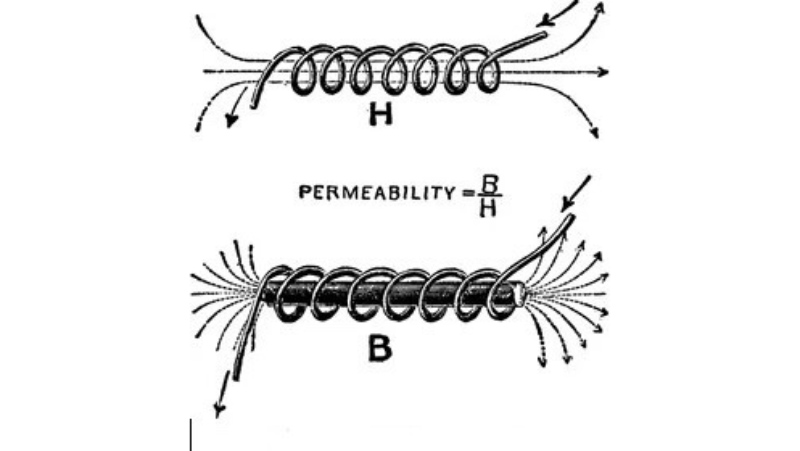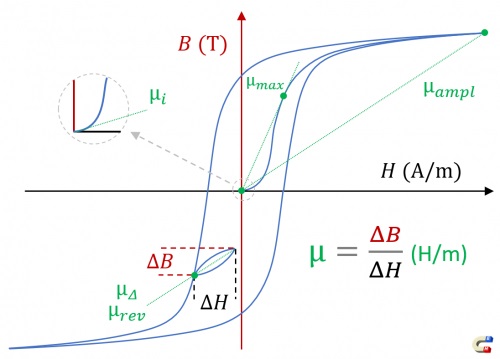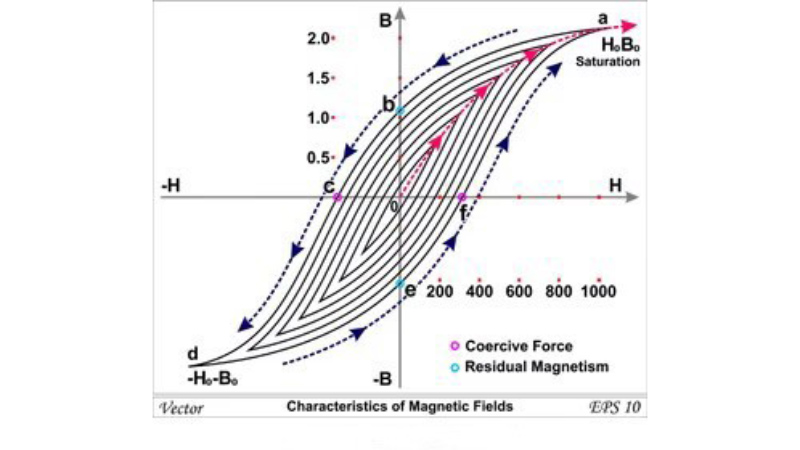What Is Magnetic Permeability?
Magnetic permeability is a measure of the ability of a material to support the formation of a magnetic field within itself. A material can magnetize in response to an applied magnetic field. In other words, it measures how easily a magnetic field can pass through a material.
The magnetic permeability of a material is represented by the symbol μ and is usually measured in units of Henries per meter (H/m). The higher the value of μ, the more quickly the material can be magnetized and the stronger the resulting magnetic field.
Main Types of Magnetic Permeability
Magnetic permeability is a measure of how easily a material can be magnetized. There are two main magnetic permeability types: intrinsic and relative.
Intrinsic permeability measures a material’s ability to support forming a magnetic field. This type of permeability is a fundamental property of the material and is independent of the size and shape of the material. Intrinsic permeability is typically represented by the symbol “μi” and is measured in units of Henries per meter (H/m).
Relative permeability, on the other hand, is a measure of the magnetic response of a material compared to that of a reference material, typically vacuum or air. This type of permeability is dependent on the size and shape of the material, as well as its intrinsic permeability. Relative permeability is typically represented by the symbol “μr” and is dimensionless.

How materials classify based on their magnetic permeability?
Materials can be classified into three categories based on their magnetic permeability: ferromagnetic materials, paramagnetic materials, and diamagnetic materials.
Ferromagnetic materials, such as iron, cobalt, and nickel, have a high magnetic permeability and can easily be magnetized. These materials are strongly attracted to magnets and can be magnetized to a high degree.
Paramagnetic materials, such as aluminum and platinum, have a slightly lower magnetic permeability than ferromagnetic materials. These materials are weakly attracted to magnets and can be magnetized to a lesser degree than ferromagnetic materials.
Diamagnetic materials, such as copper and gold, have a very low magnetic permeability and are not easily magnetized. These materials are not attracted to magnets and are difficult to magnetize.

Permeability of Hard Magnetic Materials
Hard magnetic materials, such as neodymium iron boron (NdFeB) and samarium cobalt (SmCo), have a high permeability, which means they can support strong magnetic fields. This makes them useful for applications such as permanent magnets, which are used in many electronic devices.
Permeability of Soft Magnetic Materials
On the other hand, soft magnetic materials have low permeability and are easily magnetized and demagnetized. Examples of soft magnetic materials include iron, nickel, and cobalt. These materials are often used in applications where a strong magnetic field is not required, such as in transformer cores and electric motors.
Factors Affect The Magnetic Permeability
Several factors can affect the magnetic permeability of a material. These include:
• Temperature: In general, the magnetic permeability of a material decreases as the temperature increases. This is because the thermal motion of the atoms within the material disrupts the alignment of the dipoles, reducing the material’s ability to support a magnetic field.
• Magnetic field strength: A material’s magnetic permeability often depends on the strength of the applied magnetic field. At low field strengths, the magnetic permeability may be relatively constant. However, at high field strengths, the magnetic permeability may decrease.
• Presence of other materials: The magnetic permeability of a material can be affected by the presence of other materials near it. For example, the permeability of a material may be reduced in the presence of a ferromagnetic material, which has a strong magnetic field of its own.
• Material type: Different materials have different magnetic permeabilities. For example, iron has a higher magnetic permeability than copper, so it is better at supporting the formation of a magnetic field.
• Material composition: The magnetic permeability of a material can also be affected by its composition. For example, the magnetic permeability of an alloy such as steel may be different from that of the pure elements that make up the alloy.
• Material structure: The magnetic permeability of a material can also be affected by its structure. For example, the permeability of a magnetically ordered material such as a ferromagnet may differ from that of a disordered material such as a paramagnet.
Dipoles And Magnetic Permeability
The relationship between dipoles and magnetic permeability is not a direct one. Dipoles measure the separation of positive and negative electric charges or magnetic poles, whereas magnetic permeability measures how easily a material can be magnetized.
However, the presence of dipoles in a material can affect its magnetic permeability. Materials with a high concentration of dipoles, such as ferromagnetic materials, have a higher magnetic permeability than materials with a low concentration of dipoles. This is because the dipoles in the material can align with an external magnetic field, increasing the magnetic field within the material and making it easier for the material to be magnetized.
So, the presence of dipoles in a material can affect its magnetic permeability by increasing its magnetization ability. This relationship is essential in understanding the magnetic properties of different materials.
Hysteresis Loop And Magnetic Permeability
The relationship between permeability and the hysteresis loop is that materials with high permeability have a narrow and tall hysteresis loop. In contrast, materials with low permeability have a wider hysteresis loop. This is because materials with high permeability are easily magnetized and demagnetized, whereas materials with low permeability are more difficult to magnetize and demagnetize.

Several additional factors can influence a material’s hysteresis loop and identify its magnetic characteristics. For example, materials with a wider hysteresis loop generally exhibit the following properties:
- They have lower magnetic permeability, making it more difficult to magnetize and demagnetize.
- They have a higher magnetic saturation, which means they can support a stronger magnetic field before becoming magnetically saturated.
- They have a higher magnetic retentivity, so they can retain their magnetization for a longer period after the external magnetic field is removed.
- They have a higher magnetic coercivity, requiring a higher magnetic field strength to become magnetized and demagnetized.
Magnetic Reluctance And Magnetic Permeability
Magnetic reluctance measures how difficult it is for magnetic flux to pass through a material. It is the opposition to the flow of magnetic flux, and it is the reciprocal of magnetic permeability. In other words, materials with high magnetic reluctance have low magnetic permeability, and materials with low magnetic reluctance have high magnetic permeability.
The following equation defines the relationship between magnetic reluctance and magnetic permeability:
Reluctance = 1 / Permeability
Materials with high magnetic reluctance are generally more difficult to magnetize than materials with low magnetic reluctance. This is because the magnetic field within the material is weakened by the material’s high reluctance, making it more difficult for the material to be magnetized.
Magnetic reluctance and magnetic permeability are related, with high reluctance corresponding to low permeability and low reluctance corresponding to high permeability. The relationship between these two quantities is vital in understanding the magnetic properties of different materials.
Induced Magnetic Fields And Magnetic Permeability
The relationship between magnetic permeability and induced magnetic fields is that a material with a high magnetic permeability will be more easily magnetized and produce a stronger induced magnetic field. This is because materials with high magnetic permeability have a greater ability to support the formation of a magnetic field within them.
Significance Of Magnetic Permeability?
The significance of magnetic permeability is that it determines the magnetic behavior of a material. Materials with high magnetic permeability are easily magnetized. They can support a strong magnetic field, whereas materials with low magnetic permeability are more difficult to magnetize and cannot support as strong a magnetic field.
Magnetic permeability is an essential property of materials and has a wide range of applications. Some current and future applications of magnetic permeability include:
• Electrical motors and generators: The magnetic properties of the materials used in the construction of electric motors and generators are critical for their performance. Materials with high magnetic permeability are used for the magnetic cores of motors and generators because they can easily be magnetized and support a strong magnetic field. This allows the motors and generators to operate efficiently and effectively.
• Magnetic storage devices: Materials with high magnetic permeability are used for the magnetic recording media in magnetic storage devices, such as hard drives and magnetic tapes. This allows the data to be stored reliably and retrieved accurately.
• Electromagnetic shielding: Materials with low magnetic permeability are used for electromagnetic shielding because they can block or redirect electromagnetic fields. This is important in applications where electromagnetic interference needs to be reduced or eliminated, such as in electronic devices and medical equipment.
• Magnetic resonance imaging (MRI): MRI is a medical imaging technique that uses magnetic fields and radio waves to produce detailed images of the body’s internal structures. The magnetic permeability of the materials used in MRI machines is essential for their performance and accuracy. produce detailed images of the body’s internal structures. The magnetic permeability
• Magnetic refrigeration: Magnetic refrigeration is a cooling technology that uses magnetic fields to transfer heat from one location to another. The magnetic permeability of the materials used in magnetic refrigeration systems is vital for their performance and efficiency.
If you want to explore in magnetic permeability essentials, here is a great video to show you more.
Conclusion
Understanding the concept of magnetic permeability is important for several reasons. It helps us understand how magnetic materials behave and can be used in various applications, such as in the design of electrical motors and generators. Furthermore, by gaining a deeper understanding of magnetic permeability, we can continue to advance our knowledge of the fundamental principles of magnetism and make new and exciting technological advances. So, don’t wait any longer – start learning about magnetic permeability today!
